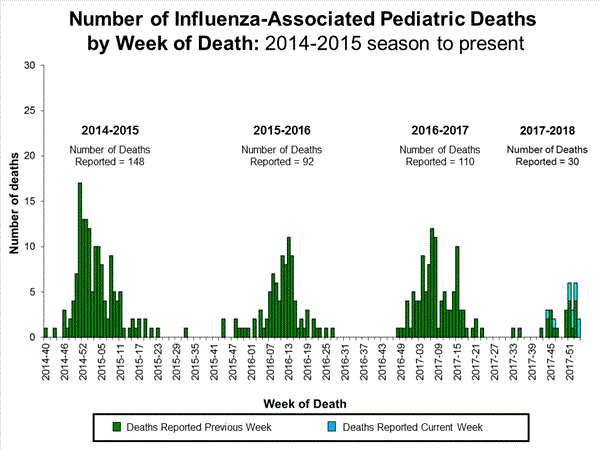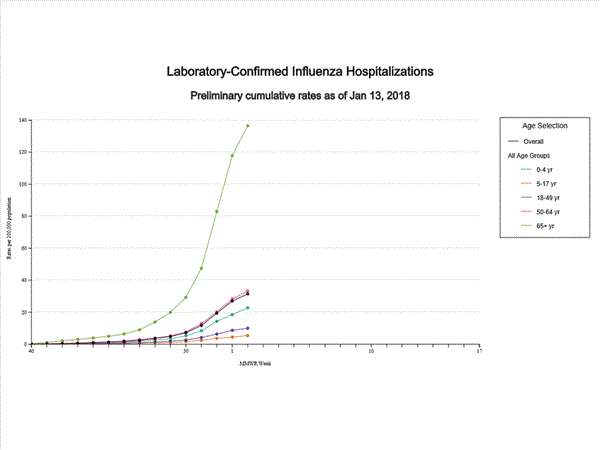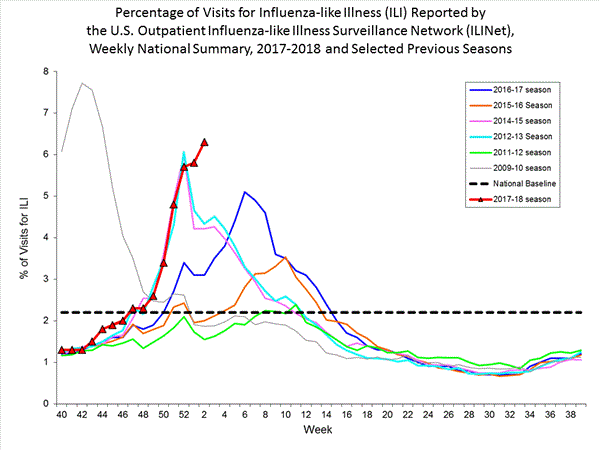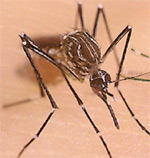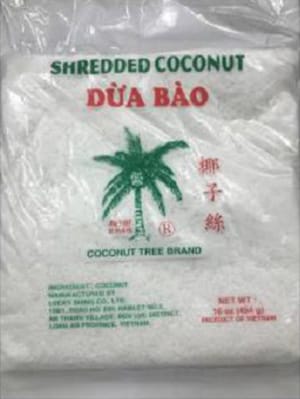Archive for January, 2018
During week 2 (January 7-13, 2018), influenza activity increased in the United States.
Friday, January 19th, 2018During week 2 (January 7-13, 2018), influenza activity increased in the United States.
- Viral Surveillance: The most frequently identified influenza virus subtype reported by public health laboratories during week 2 was influenza A(H3). The percentage of respiratory specimens testing positive for influenza in clinical laboratories increased.
- Pneumonia and Influenza Mortality: The proportion of deaths attributed to pneumonia and influenza (P&I) was above the system-specific epidemic threshold in the National Center for Health Statistics (NCHS) Mortality Surveillance System.
- Influenza-associated Pediatric Deaths: Ten influenza-associated pediatric deaths were reported
- Influenza-associated Hospitalizations: A cumulative rate of 31.5 laboratory-confirmed influenza-associated hospitalizations per 100,000 population was reported.
- Outpatient Illness Surveillance: The proportion of outpatient visits for influenza-like illness (ILI) was 6.3%, which is above the national baseline of 2.2%. All 10 regions reported ILI at or above region-specific baseline levels. New York City, Puerto Rico, and 32 states experienced high ILI activity; 9 states experienced moderate ILI activity; the District of Columbia and six states experienced low ILI activity; and three states experienced minimal ILI activity.
- Geographic Spread of Influenza: The geographic spread of influenza in Puerto Rico and 49 states was reported as widespread; Guam reported regional activity; the District of Columbia and one state reported local activity; and the U.S. Virgin Islands reported sporadic activity.
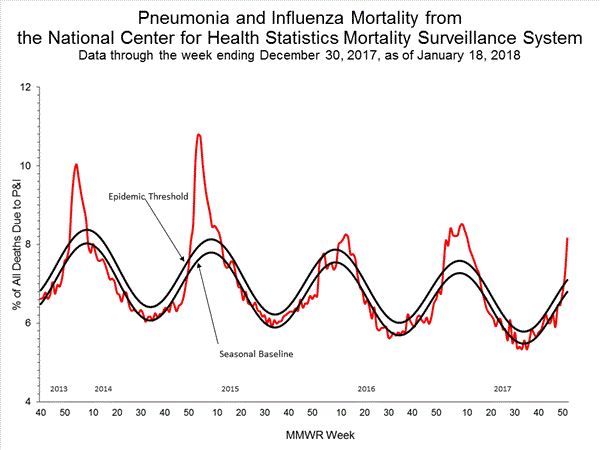
An 8-month-old baby was reportedly killed and 15 others injured after a car crashed into a crowd on Rio de Janeiro’s famous Copacabana beach in Brazil Thursday night.
Friday, January 19th, 2018“A powerful storm pummeled Europe with high winds and snow Thursday, killing at least seven people in three countries, grounding flights, halting trains, ripping roofs off buildings and flipping over trucks. ….”
Friday, January 19th, 2018“….. wind gusts of up to 87 mph in the southern port of Hook of Holland….”
https://www.youtube.com/watch?v=WeFryjME7c0
Zika virus was discovered in the salivary glands of five mosquito species caught in the wild in Mexico, including three previously unreported
Friday, January 19th, 2018Zika Virus in Salivary Glands of Five Different Species of Wild-Caught Mosquitoes from Mexico
Scientific Reports 8, Article number: 809 (2018)
doi:10.1038/s41598-017-18682-3
“…..The authors conclude, “To the best of our knowledge this is the first report that shows the presence of ZIKV [Zika virus] in the salivary glands of wild-caught female mosquitoes Cx. coronator, Cx. tarsalis, and Ae. vexans, as well as and in Ae. aegypti and Cx. quinquefasciatus, which have already been reported as potential vectors for ZIKV.….”
Gunmen in Pakistan shot and killed two women working on a polio eradication campaign
Friday, January 19th, 2018“….Sakina Bibi, 50, and her 20-year-old daughter, Alizah, were giving immunization drops to children when two gunmen riding on a motorcycle shot them….Efforts to eradicate the disease have been undermined by opposition from militants, who say immunization is a foreign ploy to sterilize Muslim children or a cover for Western spies…….”
January 18, 1969: The worst weather-related disaster in California in the 20th century.
Thursday, January 18th, 2018A double suicide bombing at a market in Nigeria’s northern city of Maiduguri killed at least 12 people and wounded 48 others
Thursday, January 18th, 2018M 4.2 – 2km NE of The Geysers, CA
Thursday, January 18th, 2018

Structure Information Summary
Overall, the population in this region resides in structures that are highly resistant to earthquake shaking, though some vulnerable structures exist. The predominant vulnerable building types are unreinforced brick masonry and reinforced masonry construction.
Secondary Effects
Recent earthquakes in this area have caused secondary hazards such as landslides and liquefaction that might have contributed to losses.
Multistate Outbreak of Salmonella Infections Linked to Coconut Tree Brand Frozen Shredded Coconut
Wednesday, January 17th, 2018Posted January 16, 2018 3:45 PM ET
Multistate Outbreak of Salmonella Infections Linked to Coconut Tree Brand Frozen Shredded Coconut
![People infected with the outbreak strains of Salmonella I,4,[5],12:b:- or Salmonella Newport, by state of residence, as of January 12, 2018](https://www.cdc.gov/salmonella/coconut-01-18/images/map/big-map-1-12-18.jpg)
Highlights
- CDC, public health and regulatory officials in several states, and the U.S. Food and Drug Administration are investigating a multistate outbreak of Salmonella infections.
- Twenty-five people infected with the outbreak strains of Salmonella I 4,[5],12:b:- or Salmonella Newport have been reported from nine states.
- Six ill people have been hospitalized. No deaths have been reported.
- Epidemiologic, laboratory, and traceback evidence(https://www.cdc.gov/foodsafety/outbreaks/investigating-outbreaks/index.html) indicates that Coconut Tree Brand Frozen Shredded Coconut, distributed by Evershing International Trading Company, is the likely source of this multistate outbreak.
- On January 3, 2018, Evershing International Trading Company recalled all 16 oz. Coconut Tree Brand Frozen Shredded Coconut after Salmonella was identified in the product by officials in Massachusetts.
- CDC recommends that retailers not sell, restaurants not serve, and consumers not eat recalled frozen shredded coconut.
- The recalled product was packaged in 16-ounce plastic bags labeled as Coconut Tree Brand Shredded Coconut.
- If you have recalled frozen shredded coconut in your home, you can return it to the place of purchase for a refund.
- If you aren’t sure if the frozen coconut you bought is Coconut Tree Brand frozen Shredded Coconut, you can ask the place of purchase. Restaurants and retailers can ask their supplier.
- When in doubt, don’t eat, sell, or serve it. Throw it out.
- Wash and sanitize countertops as well as drawers or shelves in freezers or refrigerators(https://www.cdc.gov/foodsafety/communication/clean-refrigerator-steps.html) where frozen shredded coconut was stored.
- This investigation is ongoing. CDC will provide updates when more information is available.
Initial Announcement
January 16, 2018
CDC, public health and regulatory officials in several states, and the U.S. Food and Drug Administration (FDA) are investigating a multistate outbreak of Salmonella infections.
Public health investigators are using the PulseNet(https://www.cdc.gov/pulsenet/index.html) system to identify illnesses that may be part of this outbreak. PulseNet is the national subtyping network of public health and food regulatory agency laboratories coordinated by CDC. DNA fingerprinting is performed on Salmonella bacteria isolated from ill people by using techniques called pulsed-field gel electrophoresis(https://www.cdc.gov/pulsenet/pathogens/pfge.html) (PFGE) and whole genome sequencing(https://www.cdc.gov/ncezid/dfwed/keyprograms/tracking-foodborne-illness-wgs.html) (WGS). CDC PulseNet manages a national database of these DNA fingerprints to identify possible outbreaks. WGS gives a more detailed DNA fingerprint than PFGE.
As of January 12, 2018, 25 people infected with the outbreak strains of Salmonella I 4,[5],12:b:- (24 people) or Salmonella Newport (1 person) have been reported from 9 states. A list of the states and the number of cases in each can be found on the Case Count Map(https://www.cdc.gov/salmonella/coconut-01-18/map.html) page. One more ill person infected with the outbreak strain of Salmonella I 4,[5],12:b:- has been reported from Canada.
Signs & Symptoms
What are the signs and symptoms of Salmonella infection?
Most people infected with Salmonella develop the following signs and symptoms 12-72 hours after being exposed to the bacteria:
- Diarrhea
- Fever
- Abdominal cramps
How long does the illness last?
- The illness usually lasts 4 to 7 days, and most people recover without treatment.
- In some people, the diarrhea may be so severe that the patient needs to be hospitalized. Salmonella infection may spread from the intestines to the bloodstream and then to other places in the body.
- In rare cases, Salmonella infection can cause death unless the person is treated promptly with antibiotics.
Who is more likely to have a severe illness?
- Children younger than 5 years
- Adults older than 65
- People with weakened immune systems
More information about Salmonella and steps people can take to reduce their risk of infection with Salmonella in general can be found on the CDCSalmonella(https://www.cdc.gov/salmonella/general/index.html) website.
WGS showed that isolates from people infected with Salmonella I 4,[5],12:b:- are closely related genetically. This close genetic relationship means that people in this outbreak are more likely to share a common source of infection.
Illnesses started on dates ranging from May 11, 2017 to November 4, 2017. Ill people range in age from 1 year to 82, with a median age of 19. Among ill people, 19 (76%) are male. Six people (24%) report being hospitalized. No deaths have been reported.
This outbreak can be illustrated with a chart showing the number of people who became ill each day. This chart is called an epidemic curve, or epi curve(https://www.cdc.gov/salmonella/coconut-01-18/epi.html).
Investigation of the Outbreak
Epidemiologic, laboratory, and traceback evidence(https://www.cdc.gov/foodsafety/outbreaks/investigating-outbreaks/index.html) indicates that Coconut Tree Brand frozen Shredded Coconut is the likely source of this multistate outbreak. This investigation is ongoing.
In interviews, ill people answered questions about the foods they ate and other exposures in the week before they became ill. Ten (63%) of 16 people interviewed reported eating or maybe eating coconut. Of these 10 people, 8 (80%) reported having an Asian-style dessert drink that contained frozen shredded coconut.
Throughout the outbreak investigation, state and local health officials have collected different food items from restaurants where ill people consumed Asian-style dessert drinks. In November 2017, laboratory testing of a sample from coconut milk made in one restaurant in New York did not identify the outbreak strain of Salmonella I 4,[5],12:b:-, but did identify a strain of Salmonella Newport. This sample was from coconut milk made with Coconut Tree Brand frozen Shredded Coconut, as well as other ingredients. WGS showed that the Salmonella Newport isolated from the coconut milk was closely related genetically to a Salmonella Newport isolate from an ill person from Massachusetts who had consumed an Asian-style dessert drink.
In December 2017, officials in Massachusetts collected food items from a restaurant where that ill person had consumed Asian-style dessert drinks. One sample from frozen shredded coconut identified a strain of Salmonella that was new to the PulseNet database and has not been linked to any illnesses. This sample was from an unopened package of Coconut Tree Brand Frozen Shredded Coconut. As a result, on January 3, 2018, Evershing International Trading Company recalled all Coconut Tree Brand Frozen Shredded Coconut. The recalled product was packaged in 16-ounce plastic bags.
Officials in Massachusetts returned to the restaurant and collected more Coconut Tree Brand frozen Shredded Coconut in January 2018. On January 12, laboratory testing confirmed that samples from that frozen shredded coconut identified the outbreak strain of Salmonella I 4,[5],12:b:-. Laboratory testing of other samples identified several types of Salmonella bacteria, including Salmonella Javiana, Salmonella Rissen, and Salmonella Thompson. These samples were from unopened packages of Coconut Tree Brand Frozen Shredded Coconut sold before January 3, 2018. CDC is reviewing the PulseNet database to determine if the other Salmonella isolates from the frozen shredded coconut are linked to any illnesses.
The frozen shredded coconut linked to this outbreak was used as an ingredient in Asian-style dessert drinks served at restaurants. The product was also sold in grocery stores and markets in several states. Frozen shredded coconut can last for several months if kept frozen and may still be in retail stores or in people’s homes. CDC recommends that retailers not sell, restaurants not serve, and consumers not eat recalled Coconut Tree Brand frozen Shredded Coconut.
This investigation is ongoing and we will provide updates when they are available.


